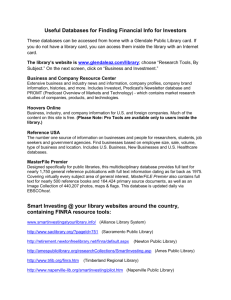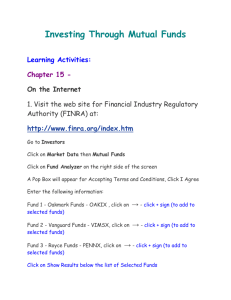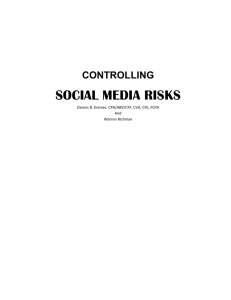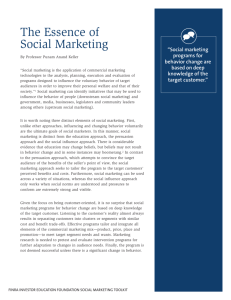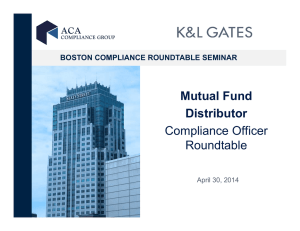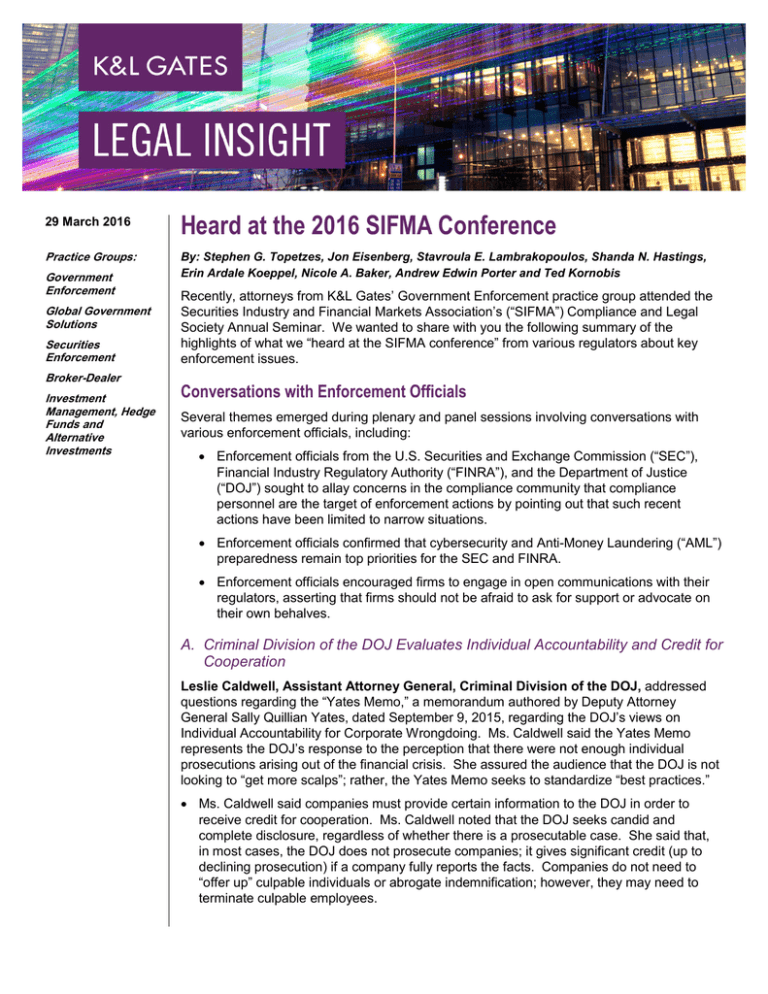
29 March 2016
Practice Groups:
Government
Enforcement
Global Government
Solutions
Securities
Enforcement
Broker-Dealer
Investment
Management, Hedge
Funds and
Alternative
Investments
Heard at the 2016 SIFMA Conference
By: Stephen G. Topetzes, Jon Eisenberg, Stavroula E. Lambrakopoulos, Shanda N. Hastings,
Erin Ardale Koeppel, Nicole A. Baker, Andrew Edwin Porter and Ted Kornobis
Recently, attorneys from K&L Gates’ Government Enforcement practice group attended the
Securities Industry and Financial Markets Association’s (“SIFMA”) Compliance and Legal
Society Annual Seminar. We wanted to share with you the following summary of the
highlights of what we “heard at the SIFMA conference” from various regulators about key
enforcement issues.
Conversations with Enforcement Officials
Several themes emerged during plenary and panel sessions involving conversations with
various enforcement officials, including:
• Enforcement officials from the U.S. Securities and Exchange Commission (“SEC”),
Financial Industry Regulatory Authority (“FINRA”), and the Department of Justice
(“DOJ”) sought to allay concerns in the compliance community that compliance
personnel are the target of enforcement actions by pointing out that such recent
actions have been limited to narrow situations.
• Enforcement officials confirmed that cybersecurity and Anti-Money Laundering (“AML”)
preparedness remain top priorities for the SEC and FINRA.
• Enforcement officials encouraged firms to engage in open communications with their
regulators, asserting that firms should not be afraid to ask for support or advocate on
their own behalves.
A. Criminal Division of the DOJ Evaluates Individual Accountability and Credit for
Cooperation
Leslie Caldwell, Assistant Attorney General, Criminal Division of the DOJ, addressed
questions regarding the “Yates Memo,” a memorandum authored by Deputy Attorney
General Sally Quillian Yates, dated September 9, 2015, regarding the DOJ’s views on
Individual Accountability for Corporate Wrongdoing. Ms. Caldwell said the Yates Memo
represents the DOJ’s response to the perception that there were not enough individual
prosecutions arising out of the financial crisis. She assured the audience that the DOJ is not
looking to “get more scalps”; rather, the Yates Memo seeks to standardize “best practices.”
• Ms. Caldwell said companies must provide certain information to the DOJ in order to
receive credit for cooperation. Ms. Caldwell noted that the DOJ seeks candid and
complete disclosure, regardless of whether there is a prosecutable case. She said that,
in most cases, the DOJ does not prosecute companies; it gives significant credit (up to
declining prosecution) if a company fully reports the facts. Companies do not need to
“offer up” culpable individuals or abrogate indemnification; however, they may need to
terminate culpable employees.
Heard at the 2016 SIFMA Conference
• Ms. Caldwell suggested that, when companies evaluate whether self-disclosure is
“worth it,” they should consider that the DOJ recently added a “self-reporting” factor to
the existing “Filip factors” (the DOJ’s guidelines for the investigation and prosecution of
corporate fraud). She said the DOJ aims to give greater credit for self-reporting and
also to create a greater “delta” between the companies that self-report and those that
do not.
• Ms. Caldwell said a good compliance program may uncover potential issues. The
DOJ’s new Compliance Counsel, Hui Chen, the former head of compliance for
Standard Chartered Bank and ex-assistant general counsel at Pfizer Inc., has been
tasked with helping the DOJ review compliance programs from an informed, intelligent
perspective. There is no “one-size-fits-all” compliance program; they should be
tailored to a firm’s business and risk profile, as appropriate.
Panelist Discussions About the Impact of the Yates Memo. The Yates Memo continues
to be of interest to the defense bar. During the conference, other panelists stated that the
impact of the Yates Memo remains to be seen. On the one hand, some stated that long
before the Yates Memo, corporations and individuals were on notice that the government
has been looking very hard at individual accountability in financial fraud cases and that this
has been particularly true in major financial fraud investigations brought by the United States.
On the other hand, the Yates Memo now generally prohibits global waivers that cover
individuals; that part of the Memo is new. One panelist expressed concern that the Yates
Memo encourages more cooperation between the civil and criminal sides of the DOJ and
that there is a risk that civil settlements will be extracted by threatening criminal prosecution.
Others stated, however, that there has long been cooperation and communication between
the civil and criminal sides of DOJ. One practical result of the Yates Memo may be a greater
reluctance of company executives to cooperate in internal investigations.
Sung-Hee Suh, Deputy Assistant Attorney General, Criminal Division of the DOJ,
addressed regulatory “pile-on.” She said the DOJ is working to coordinate with other
regulators “from the get-go.” She noted that the number of declinations related to the
Foreign Corrupt Practices Act (“FCPA”) has increased because the SEC is addressing many
of the cases, instead, and that “the adequacy of remedies such as civil or regulatory
enforcement actions” is one of the Filip factors the DOJ considers in determining whether to
prosecute. Also, the DOJ considered the amounts banks paid to other regulators when
levying penalties in connection with the recent LIBOR actions.
• Ms. Suh confirmed that, going forward, civil settlements will not contain individual
releases. She noted that the Filip factors now require the DOJ to consider “the
adequacy of the prosecution of individuals responsible for the corporation's
malfeasance” when determining whether companies should receive credit for
cooperation.
• Ms. Suh stated that settling companies seeking cooperation credit are not required to
execute a written certification confirming that all non-privileged information about
individuals involved in the alleged wrongdoing has been fully disclosed.
2
Heard at the 2016 SIFMA Conference
B. SEC Continues to Involve Specialized Units in Enforcement Efforts
Andrew Ceresney, Director, Division of Enforcement of the SEC, noted that the
Enforcement Division has created a new unit to evaluate complex financial instruments. The
unit covers the creation, sale, usage, and valuation of commercial mortgage-backed
securities (“CMBS”) and credit default swaps (“CDS”), among other things. It also focuses
on issues relating to structured and convertible notes, including fee disclosure, actual fees,
and suitability. Mr. Ceresney noted that the Enforcement Division is using FINRA TRACE
data to mine for potential misconduct.
Mr. Ceresney also discussed the Enforcement Division’s current focus on market structure.
Mr. Ceresney noted that the SEC recently brought cases against exchanges, dark pools, and
alternative trading systems (“ATS”). Among other things, Mr. Ceresney also discussed a
settlement involving a high-frequency trading firm charged with fraudulent trading to
manipulate closing prices. Also, Mr. Ceresney noted that the SEC has brought six spoofing
cases in the last six years.
Mr. Ceresney briefly mentioned that the Asset Management Unit has participated in several
recent cases concerning private equity fee disclosures. He subsequently discussed a recent
proceeding involving a compliance officer. Investment Company Act Release No. 31558
(April 20, 2015). Mr. Ceresney affirmed that compliance officers are not targets, noting that
the Enforcement Division has brought cases involving compliance officers (1) after personal
misconduct, (2) if the company misled regulators, or (3) if the compliance officer failed to
carry out his or her responsibilities. He distinguished this conduct from cases alleging a
failure of policies and procedures under Rule 206(4)-7 of the Investment Advisers Act.
C. FINRA Focuses on Firm Culture
Richard Ketchum, Chairman and Chief Executive Officer of FINRA, offered his insight
into current FINRA concerns. Mr. Ketchum referred to FINRA’s 2016 Regulatory and
Examination Priorities Letter in identifying the areas of focus.
• Mr. Ketchum said that “firm culture” remains a topic of emphasis for FINRA. He
defined “firm culture” to include: the manner in which compliance and controls are
valued in a firm; whether a firm acts proactively to reduce conflicts; a firm’s reaction to
policy or control violations; and the firm’s means of addressing sub-cultures within the
firm. Mr. Ketchum recognized that firm culture will vary across firms, noting that firm
culture may signify something different for large firms than for smaller firms.
• Cybersecurity will continue to be an area of focus for FINRA. Mr. Ketchum said firms
should consider how they are prepared for both external and internal threats to
cybersecurity. He specifically mentioned the need for firms to be diligent in vendor
management and training. Mr. Ketchum also emphasized that firms should implement
effective firmwide cybersecurity efforts. He noted that some firms may have
impressive centralized cybersecurity controls, but they are not effective at the branch
office level.
• Mr. Ketchum said FINRA will continue to invest its resources in advanced data
analytics. FINRA achieves efficiencies by collecting and reviewing data prior to exams
3
Heard at the 2016 SIFMA Conference
because it helps the staff to focus its priorities during the exam. FINRA continues to
be technology-driven and analytic in its efforts to understand firms.
• Senior and vulnerable investors are also areas of focus for FINRA. Mr. Ketchum said
that this is particularly true given the increasing amount of money being managed by
these populations. Mr. Ketchum highlighted FINRA’s National Senior Investment
Initiative and hotline to protect senior citizen investors, noting that this is an area of
continued focus by FINRA as the U.S. baby boomer population ages and retires. He
suggested that investment-related communications with senior citizens may differ from
communications with other customers, as greater care should be taken with senior
citizens. He noted the success of FINRA’s hotline for senior citizens, which has
resulted in significant voluntary resolutions of their complaints by the industry.
J. Bradley Bennett, Executive Vice President, FINRA Enforcement, said FINRA
contends with the same problems and concerns every year, regardless of market conditions.
These include issues arising in connection with outside business activities, private securities
transactions, and concerns relating to the elderly. Mr. Bennett noted that approximately 800
registered representatives were barred in 2015 (about the same number as 2014).
• Mr. Bennett advised firms to be mindful of FINRA’s target examination letter
concerning “firm culture,” but said that FINRA does not anticipate bringing any
enforcement actions based solely on “bad culture.”
• FINRA Enforcement will focus on several issues this year, including anti-money
laundering and annuities (particularly L shares coupled with certain riders, such as the
guaranteed minimum income benefit).
Later, Susan Axelrod, FINRA Executive Vice President of Regulatory Operations;
Michael G. Rufino, FINRA Executive Vice President, Head of Member Regulation; Bill
Wollman, FINRA Executive Vice President, Member Regulation; Robert Colby, FINRA
Executive Vice President and Chief Legal Officer; Thomas Gira, FINRA Executive Vice
President, Market Regulation; and Brad Bennett, provided additional insight into current
FINRA concerns. The panel briefly revisited the earlier discussion of FINRA’s ongoing “firm
culture” review. Mr. Bennett reiterated that the review is “not a tool for enforcement.”
• Mr. Bennett also said FINRA is not looking to bring cases against compliance officers;
however, it may do so if they do not fulfill responsibilities assigned to them.
• Mr. Rufino noted that FINRA is focusing on recidivist brokers. Since 2013, FINRA has
utilized a high-risk broker program; approximately 216 brokers have taken bars since
then. Mr. Rufino said examinations are not staffed with attorneys. However, FINRA
attorneys may be involved in dialogues with risky firms. He opined that there is a “fine
line” between examinations and investigations.
• Mr. Wollman said FINRA has focused on technological governance, including
cybersecurity, for a number of years. He noted that no FINRA rule specifically
addresses cybersecurity. Instead, FINRA evaluates operational risk by focusing on
controls and governance issues, including firms’ responses to incidents and generic
controls issues (particularly relating to vendor management).
4
Heard at the 2016 SIFMA Conference
With respect to “Private Client Regulatory Enforcement,” Susan Schroeder, FINRA Deputy
Chief of Enforcement, noted that FINRA has observed that firms may have guidance in
place regarding suitability, but FINRA is finding that firms may not be adequately
implementing their suitability guidance. She stated that a firm’s suitability program must be
robust and iterative. Firms should revisit their programs periodically.
When discussing “The Inside Job and Outside Threat: Protecting Your Firm and Clients
Against Fraud,” Cameron Funkhouser, Executive Vice President, FINRA’s Office of
Fraud Detection and Market Intelligence, highlighted instances in which a firm’s quick
reporting of suspicious activity allowed FINRA to identify individuals engaging in insider
trading and other improper activity in “real time.” He stated that firms play an important role
as a neighborhood watch group.
D. CFTC Continues Post-Dodd Frank Enforcement Efforts
Aitan Goelman, Director, Division of Enforcement of the U.S. Commodity Futures
Trading Association (“CFTC”), said the CFTC is focusing on anti-manipulation, spoofing,
and reporting. Mr. Goelman also noted that the CFTC intends to bring more cases as
administrative proceedings if the CFTC is able to hire administrative law judges. Mr.
Goelman noted the CFTC’s relatively small budget and lamented the agency’s need to
receive, store, and analyze vast quantities of data with few financial resources. He stated
that budget pressures may cause the CFTC to consider bringing enforcement actions
against firms who produce “bad data.”
Hot Topics
A. Cybersecurity Continues to be a Top Priority for all Regulatory and Firms
As recent SEC and FINRA enforcement actions have shown, cybersecurity remains a top
regulatory priority. Governments and regulators, both domestic and abroad, are taking
different approaches in providing guidance on cybersecurity preparedness and
responsibilities.
Leonard Baily, Special Counsel for National Security in the DOJ’s Computer Crime
and Intellectual Property Section, commented on the Cybersecurity Information Sharing
Act. Mr. Baily noted that the Act establishes a framework that incentivizes private sector
sharing of cyberthreat information by providing, among other things, liability protection for
information sharing for the purposes of cybersecurity. The Act also authorizes monitoring
and the application of defensive measures on networks for cybersecurity purposes.
B. Anti-Money Laundering Issues Stay on the Radar
Clay Porter, Deputy Chief of the Money Laundering and Bank Integrity Unit of the DOJ,
repeated a theme emphasized throughout the conference: a compliance department can
only be successful if the “business” buys into it and acts as the first line of defense.
Compliance should be perceived as more than a cost center; compliance efforts will not work
if the business is not on board.
5
Heard at the 2016 SIFMA Conference
• Mr. Porter also explained that a compliance department must be “willing to battle”
when needed to raise issues. Mr. Porter offered a much-repeated theme: compliance
officers are not necessarily in the department’s crosshairs; instead, prosecutors follow
the evidence, which often leads them to the business side.
• Compliance departments should be on the lookout for companies that purport to do
one thing but, in fact, do another. Client service personnel should ask the “right
questions” to these clients and verify their answers, and compliance should also
evaluate this information, question it, and assess whether they have enough comfort.
• With respect to cross-border information sharing, Mr. Porter explained that the DOJ
does not want companies to violate any jurisdiction’s privacy laws, but noted that the
DOJ has seen some companies (and their counsel) treat the same country’s privacy
laws in different ways. He emphasized that companies cannot give up on efforts to
obtain data because it is difficult.
• Regarding the Yates Memo, Mr. Porter was careful to point out that the DOJ is not
asking companies to become prosecutors and said that, if a company does not think
any individuals were involved in wrongdoing, the company should simply provide the
facts and the DOJ will decide how to move forward. He also mentioned that in the six
months since the Yates Memo was released, the DOJ is already receiving documents,
citing to so-called “Yates binders” that companies have been submitting.
C. Firms Grapple with Department of Labor Issuance of Final Fiduciary Rule
Although there were no Department of Labor (“DOL”) officials present at the conference,
industry participants engaged in discussions regarding the final fiduciary rule the DOL is
expected to issue in coming weeks. The DOL proposed the rule in April 2015 and, after an
extensive comment period, on January 28, 2016, sent the final regulation to the Office of
Management and Budget for review prior to publication in the Federal Register.
• The issuance of a DOL fiduciary rule may have significant reach as it is expected to
expand the scope of financial professionals who will be subjected to the Employee
Retirement Income Security Act of 1974 (“ERISA”) fiduciary standards and “prohibited
transaction” (conflict of interest) rules. The industry anticipates that the proposed rule
will address perceived conflicts of interest arising from recommendations by financial
professionals to retirement plans, plan participants, and individual retirement accounts
(“IRAs”).
• Under the DOL’s anticipated fiduciary rule, a financial professional would be subject to
ERISA’s fiduciary standards if the person, for a fee or other direct or indirect
compensation, provides investment or investment management recommendations
(including regarding distributions and rollovers) or appraisals to an employee benefit
plan, a plan fiduciary, participant or beneficiary, or an IRA owner and either directly or
indirectly (e.g., through or together with an affiliate): (1) represents or acknowledges
fiduciary status, or (2) provides the advice under an agreement, arrangement, or
understanding that the advice is individualized to, or specifically directed to, the advice
recipient for consideration in making investment or management decisions with
respect to plan or IRA assets.
6
Heard at the 2016 SIFMA Conference
• Many of the routine actions of financial professionals relating to IRAs, including
rollover and distribution advice, investment education, and asset allocation
discussions, would be subject to fiduciary status under the new rule. The new rule is
likely to expand the definition of “advice” to include recommendations of fee-based
advisers and managers. The advice need not be “regular” to be subject to fiduciary
standards.
• Panelists expect that the new rule will cause firms to consider realigning their
products, to update their policies and procedures to adopt new fiduciary, “impartial
conduct,” and conflict of interest policies and procedures, to institute new supervisory
procedures, to review their contracts and marketing materials and disclosures, and to
provide training to their employees.
• Following comments to the initially proposed rule, the DOL is expected to provide
some narrow carve outs from fiduciary status for: sophisticated large plans and
managers but not small plans or IRAs; 401(k) platforms; investment education; swaps
and employees of plan sponsors.
• ERISA prohibits a fiduciary from receiving variable compensation or third-party
payments in connection with the advice unless a “prohibited transaction” exemption
covers the fiduciary’s activities. The anticipated rule is expected to provide for a Best
Interest Contract (“BIC”) class exemption that would apply to persons providing nondiscretionary investment advice to retirement investors in order to permit their receipt
and retention of third-party compensation in connection with the advice. The BIC
exemption would apply to agency transactions in certain securities and principal
transactions for certain debt securities.
• Panelists suggested that the extreme complexities of the contemplated BIC exemption
may render it unworkable. The BIC exemption would not cover small plans, IRA
rollover recommendations, or manager recommendations. At minimum, burdensome
disclosure requirements at the point of sale, both annually and on an ongoing basis,
may be imposed. Whether a BIC exemption would be available would depend on the
firm’s ability to fundamentally change “asset” availability, pricing, and compensation to
the financial professionals.
• Industry representatives expressed concern that the new rule could effectively limit
access to advice for smaller clients while “re-engineering” the process for making
recommendations for managed, fee-based, and wrap accounts. Questions remain as
to how DOL would enforce a new fiduciary rule and how such efforts would be
coordinated with other regulators, including the SEC and FINRA, as well as a possible
uniform fiduciary standard to be proposed by the SEC.
D. Continued Emphasis on Senior and Retirement Issues
Susan Axelrod discussed senior and retirement issues, expanding upon comments made
earlier by Richard Ketchum. Ms. Axelrod described FINRA’s and other regulators’ efforts to
contend with the aging population.
• Specifically, Ms. Axelrod described rising concerns by regulators about seniors and
complex investment products and the establishment by FINRA in April 2015 of the
7
Heard at the 2016 SIFMA Conference
Securities Helpline for Seniors (“HELPS”). HELPS is staffed by dedicated FINRA
personnel to provide personalized, outcome-oriented assistance to seniors.
• To date, over $1 million has been returned by firms to senior investors voluntarily as a
direct result of inquiries initiated from HELPS.
• FINRA issued a senior investor protection proposal in October 2015 (Regulatory
Notice 15-37). Specifically, FINRA proposed new rules to provide firms with a way to
respond to situations where they have a reasonable basis to believe that financial
exploitation of vulnerable adults has occurred, is occurring, has been attempted, or
may be attempted.
E. New FINRA Research Rules Expand Member Firm Obligations
Philip Shaikun, Vice President and Associate General Counsel in FINRA’s Office of
General Counsel, commented on FINRA’s revised equity research rule and its new debt
research rule.
• As Mr. Shaikun explained, FINRA Rule 2241 was adopted from the legacy NASD
Rule 2711. FINRA Rule 2241 contains both overarching principles and specific
proscriptions, including: obligations of employees to comply with firm’s policies and
procedures, principles-based personal trading restrictions, quiet period reductions for
IPOs and secondary offerings, selective dissemination interpretation, exemption from
the compensation provision for limited investment banking activity, exemption from
registration requirements for non-research analysts, and the elimination of the annual
attestation requirement. All of the requirements contained in FINRA Rule 2241 were
effective as of December 24, 2015.
Mr. Shaikun reported that FINRA released selected “frequently asked questions” (“FAQs”)
regarding FINRA Rules 2241 and 2242 on March 4, 2016. These new FAQs supplemented
prior FAQs issued by FINRA on May 27, 2015, in the wake of FINRA’s settlement with ten
firms in connection with the 2010 planned initial public offering of Toys “R” Us (the “Toys
Settlement”).
• The Toys Settlement, in which the ten firms agreed to pay FINRA a total of $43.5
million in sanctions, related to charges by FINRA that the firms allowed their equity
research analysts to solicit investment banking business and offered favorable
research coverage in order to secure a role in the proposed Toys “R” Us IPO. Mr.
Shaikun observed that FINRA’s views regarding “pre-mandate” interactions between
research analysts and company management are reflected in the new equity research
rule and debt research rule and are equally applicable to both equity and debt
research analysts.
Mr. Shaikun and others also commented on recent FINRA examination findings, highlighting
the failure to treat certain desk commentary and other communications from outside of the
research department as “research reports,” failure to make adequate disclosures and lack of
prominence, lack of enforcement of policies around communications with subject companies,
failure to treat research by the “mixed research team” as member research, and failure to
have properly qualified principals review research.
8
Heard at the 2016 SIFMA Conference
Litigation Update
Panelists discussed major developments in civil and criminal securities related litigation in
the past year. Some of the key areas discussed follow:
A. Regulatory and Criminal Case
Collateral Consequences Make It Extremely Difficult for Large Financial Institutions to
Litigate with Regulators. Potential collateral consequences (for example, losing the ability
to serve as investment adviser to mutual funds) may make it next to impossible to litigate
with regulators. Financial institutions often cannot risk that if they litigate and lose (rather
than settle) regulators will not provide waivers of collateral consequences. Moreover,
obtaining waivers is becoming more difficult, and parties may not know at the time of
settlement whether the waivers will be granted, although an SEC panelist stated that
respondents should generally have a good idea at the time of settlement whether waivers
are likely to be granted. In many cases, the collateral consequences, if they are not waived,
would be more draconian than the penalties imposed for the conduct in the case.
Concerns About DOJ’s Retrospective Look Backs. Panelists expressed concern that
DOJ has several ongoing investigations involving a retroactive look at whether the company
was sufficiently transparent during settlement negotiations. If the government concludes that
lawyers for the company were not sufficiently transparent during the negotiations, they may
rescind the settlements. This is a problem because hindsight is 20/20 and if a lawyer made
a representation that turned out to be wrong or simply did not know something, there could
be consequences for both the company and the lawyer. There is also a prospective
concern – because a company with, for example, 50,000 employees will eventually have
repeat violations. On the other hand, panelists expressed less concern about the
prospective risk than the retrospective risk.
Second Circuit’s Reservations About Criminalizing Trader Conversations. In United
States v. Litvak, No. 14-2902-cr (2d Cir. Dec. 8, 2015), the Second Circuit remanded the
conviction of a trader who allegedly misrepresented to counterparties the costs of acquiring
certain mortgage-backed securities. The Second Circuit accepted the theory that a trader
who misrepresents material facts could be criminally liable for those misrepresentations, but
held it was error to exclude testimony relevant to whether such misrepresentations would
have been material to counterparties.
Supreme Court’s Decision in Salman Could Reverse Newman Insider Trading
Standard. In United States v. Newman, 773 F.3d 438 (2d Cir. 2014), reh’g denied, Nos. 131837, 13-1917 (2d Cir. Apr. 3, 2015), the Second Circuit held that even when an insider and
a tippee are friends, the government must prove that there was “an exchange that is
objective, consequential, and represents at least a potential gain of a pecuniary or similarly
valuable nature” to the insider. This poses an obstacle to those insider trading cases where
the insider simply gifted the information. In those cases, under Newman, the prosecution
would fail because the insider (as opposed to the tippee) received no personal benefit from
the tip. The government argues that Newman conflicts with the Supreme Court’s statement
in Dirks v. SEC, 463 U.S. 646 (1983) that insiders personally benefit from disclosing
confidential information when they “make[] a gift of confidential information to a trading
relative or friend.” On January 19, 2016, the Supreme Court agreed to decide that issue in
9
Heard at the 2016 SIFMA Conference
Salman v. United States, No. 15-628, involving an insider who allegedly tipped to a relative.
The case, however, has been put off to the next Term, and thus could be decided as late as
June 2017.
B. Major Civil Cases
Supreme Court’s Halliburton II Decision Not Limiting Class Certifications So Far.
Roughly ten district court decisions have considered efforts by defendants to defeat class
certification by arguing, under the Supreme Court’s 2014 decision in Halliburton Co. v. Erica
P. John Fund, Inc. 134 S. Ct. 2398 (2014), that the alleged misrepresentations and
omissions had no price impact. Thus far, at least ten district courts have certified class
actions despite defendants’ efforts to show a lack of price impact. Courts of appeals,
however, have yet to weigh in on these issues, and a number of the district court class
determinations are the subject of Rule 23(f) appeals to the circuit courts.
Rakoff Certifies Class Action in Petrobas Despite Individual Issues. On February 1,
2016, Judge Rakoff certified a class action in In re Petrobas Securities Litigation, No. 1409662, despite a number of individual issues, including whether investors purchased in a
domestic transaction would have to be established on an investor-by-investor basis. The
court stated that whether a transaction is domestic is likely to be documented in a form
“susceptible to the bureaucratic processes of determining who belongs to a Class.”
Courts Are Split on Removal of Claims Under the Securities Act of 1933. District courts
are badly split on removal of Securities Act claims. District courts in the Southern District of
New York permit removal; district courts within the Ninth Circuit do not permit removal and
one court recently imposed sanctions against a party that sought to remove. Appellate
courts have not weighed in on the issue.
The Pain of Benchmark Litigation. Litigation alleging collusion in setting benchmarks has
led to six banks taking criminal guilty pleas, several traders being tried and convicted, and
banks paying more than $5 billion in criminal penalties, $4 billion to resolve class actions,
and $2 billion in regulatory fines. As one panelist stated, “There is no way to put lipstick on
this pig.” Factors that have contributed to the large payments include loose and provocative
chat rooms, a rush to cooperate with law enforcement, and competition among the regulators
on who could be the toughest on financial institutions. Plaintiffs’ lawyers offer “discounts” to
early settlers, with subsequent settlers having to pay more to settle, and that has created a
race to settlement. Benchmark litigation is expected to continue for at least the next couple
of years.
Authors:
Stephen G. Topetzes
Stephen.Topetzes@klgates.com
+1.202.778.9328
Jon Eisenberg
jon.eisenberg@klgates.com
+1.202.778.9348
10
Heard at the 2016 SIFMA Conference
Stavroula E. Lambrakopoulos
stavroula.lambrakopoulos@klgates.com
+1.202.778.9248
Shanda N. Hastings
shanda.hastings@klgates.com
+1.202.778.9119
Erin Ardale Koeppel
erin.koeppel@klgates.com
+1.202.778.9420
Nicole A. Baker
nicole.baker@klgates.com
+1.202.778.9018
Andrew Edwin Porter
andrew.porter@klgates.com
+1.202.778.9360
Ted Kornobis
ted.kornobis@klgates.com
+1.202.778.9180
Anchorage
Austin
Fort Worth
Frankfurt
Orange County
Beijing
Berlin
Harrisburg
Palo Alto
Paris
Boston
Hong Kong
Perth
Brisbane
Houston
Pittsburgh
Brussels
London
Portland
Charleston
Los Angeles
Raleigh
Charlotte
Melbourne
Research Triangle Park
Chicago
Miami
Dallas
Milan
San Francisco
Doha
Newark
Dubai
New York
São Paulo
Seattle
Seoul Shanghai Singapore Sydney Taipei Tokyo Warsaw Washington, D.C. Wilmington
K&L Gates comprises approximately 2,000 lawyers globally who practice in fully integrated offices located on five
continents. The firm represents leading multinational corporations, growth and middle-market companies, capital
markets participants and entrepreneurs in every major industry group as well as public sector entities, educational
institutions, philanthropic organizations and individuals. For more information about K&L Gates or its locations,
practices and registrations, visit www.klgates.com.
This publication is for informational purposes and does not contain or convey legal advice. The information herein should not be used or relied upon in
regard to any particular facts or circumstances without first consulting a lawyer.
© 2016 K&L Gates LLP. All Rights Reserved.
11

